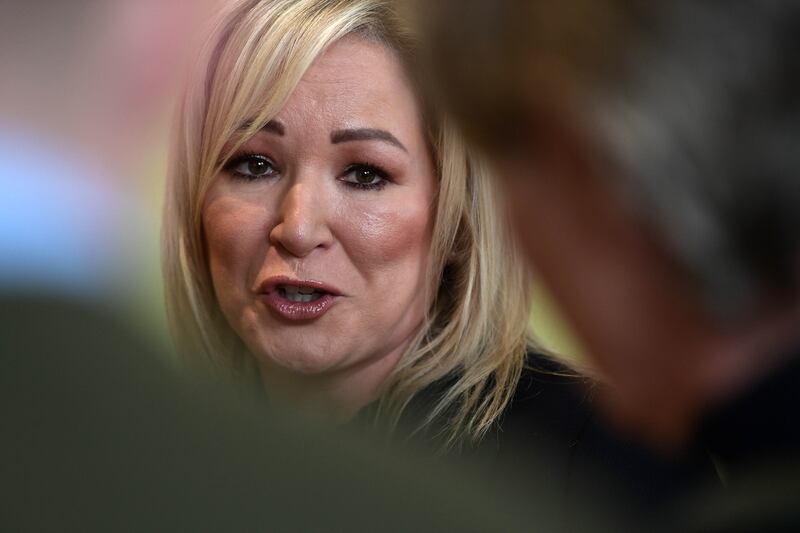Image of the week: Historic blaze
It was 400 years of Denmark’s cultural heritage in flames and not even Batman – incongruously present in the form of a building-wrap advertisement, next to the “fear nothing” ad for safety shoes Airtox – could do anything about it.
The heroes as the historic Boersen stock exchange in central Copenhagen went on fire were instead the emergency services workers and passers-by who went into the building to rescue artworks dating from the 17th century. “Hundreds of people” contributed to the effort, said Danish culture minister Jakob Engel-Schmidt, who vowed that “the dragon spire” – a reference to the intertwined dragons’ tails on the collapsed 184ft spire – would once again tower over Copenhagen.
The 1620s building, one of the oldest in the Danish capital, had been undergoing renovation work when it caught fire on Tuesday morning, prompting Danish people to refer to the blaze in dismay as their “Notre Dame” moment. Danish prime minister Mette Frederiksen called the building “irreplaceable”.
Nevertheless, Brian Mikkelsen – the chief executive of the Danish Chamber of Commerce, which owns the building – said he had been given hope in his cause to rebuild it after a firefighter passed on the ornamental metal tip of the spire.
READ MORE
In numbers: Superdry rescue
€11.7 million
Sum in euro that Superdry is hoping to raise as part of a rescue plan designed to put the 21-year-old retailer, known for its prominently logoed casual clothes, “on the right footing to secure its long-term future”.
5 pence
Share price earlier this week for the company, which once traded above 500p but has suffered widening losses on declining sales. The proposed rescue will include a move to delist from the London Stock Exchange.
26%
Stake in the company held by its founder and chief executive Julian Dunkerton, who this week said the brand was a “broad church”, hitting back at a suggestion by former Superdry chairman Peter Williams that it was “probably not as cool as it used to be”.
Getting to know: The UK’s new smoking law

Westminster MPs this week voted by 383 to 67 in favour of the Tobacco and Vapes Bill, which will make it illegal for anyone born in 2009 or later to buy tobacco products in the UK. While this sounds like the most sensible piece of legislation to come out of Downing Street in years, not everyone is a fan of Rishi Sunak’s bid to create a “smoke-free generation”. DUP MPs, for instance, joined hardcore Tories in voting against it.
First Minister Michelle O’Neill is among the many who believe it is “a good policy”, however. A legislative consent motion will be brought to the Northern Ireland Assembly and it is ultimately likely to be enforced in the North.
The “lifetime ban” was inspired by a move by former New Zealand prime minister Jacinda Ardern to similarly prohibit the sale of tobacco to anyone born after 2008. Alas, Ardern’s pioneering legislation was subsequently scrapped by New Zealand’s current prime minister, who – for the benefit of any table quizzes in your future – goes by the name Christopher Luxon.
The list: Boeing takeaways
New Boeing whistleblower Sam Salehpour, a quality engineer for the aircraft maker, testified to a Washington congressional committee investigating the company’s safety culture on Wednesday and let’s just say the testimony was not flattering. What did he have to say?
1. “Defective” planes: Salehpour said he had “serious concerns” about the safety of Boeing’s 787 and 777 aircraft and was “willing to take on professional risk to talk about them”.
2. Unorthodox approach: Boeing used “unmeasured and unlimited” force – including people jumping on pieces of the aeroplane – to correct misalignment between sections of jets, with the gap still remaining wider than Boeing’s own standards, he claimed.
3. Whistleblower harassment: Salehpour said he was berated and threatened after he queried certain practices. Although he admitted he had “no proof” that it was related to his complaints, at one point his tyre was punctured by a nail.
4. Profit over safety: Boeing, which is already facing scrutiny over the 737 Max after a midair blowout, disputed Salehpour’s remarks about the 787 and 777. But the engineer said he hoped the committee would demand an end to a culture that prioritises profit and speed over safety.
5. Poignant motivation: Salehpour said he felt compelled to speak out as he was mindful that a carpool friend had worked on the Challenger shuttle, but had his concerns ignored. The shuttle broke up mid-air soon after its launch in January 1986, killing all seven of its crew.
- Listen to our Inside Politics Podcast for the latest analysis and chat
- Sign up for push alerts and have the best news, analysis and comment delivered directly to your phone
- Find The Irish Times on WhatsApp and stay up to date













